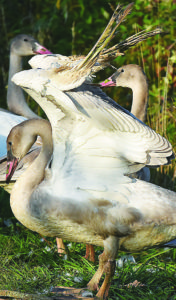Concerned citizens and government officials are working together to help a young swan with a deformity that will most likely

lead to its death if it’s not removed from the wild.
Last week, the Polly Ann Trail Management Council voted unanimously to allow the Howell Nature Center or its designee to access the trail right-of-way, just east of Lake George Rd. in Addison Twp., so that a trumpeter swan cygnet can be extracted, treated and relocated to a place where it can be cared for, protected and perhaps used to help educate the public.
“I was very pleased with the outcome,” said Shelby Township resident Mike Kent, who brought the issue to the trail council’s attention. “I know that the (Trail) Manager Linda (Moran) is very much behind the rescue of this swan.”
Trumpeter swans are the largest swan in North America with a length of 4 feet, a wingspan of 7 feet and a weight of 20 to 30 pounds. They are native to Michigan and the only native swan that breeds in the state. Trumpeters are currently on Michigan’s threatened species list, so they are legally protected.
The cygnet at the center of this rescue effort has a condition known as Angel Wing Syndrome. According to information from the Peggy Notebaert Nature Museum in Chicago, the condition affects mostly waterfowl and is caused by “a nutritional deficiency in vitamins and minerals combined with a high level of carbohydrates and sugars.” A number of factors are involved, but humans feeding waterfowl foods, such as bread and crackers, is considered one of the “probable causes” of the condition.
Angel Wing causes the carpal joints, or wrists, on the wings to grow awkwardly, which results in them being unable to sit flush at a bird’s sides. This inhibits a bird’s ability to fly and negatively impacts the growth of their primary flight feathers, which end up looking “more like sticks than feathers,” according to the Peggy Notebaert Nature Museum.
Fully-mature birds that suffer from Angel Wing are likely to die because they can’t fly to food sources and they get rejected by their flocks. However, if a bird is young enough and its diet “changes dramatically,” the nature museum indicated “the damage could be reversed.”
The deformed cygnet in Addison is one of six young swans born to a pair of adults that return to this area annually, according to Moran.
“They sleep on the trail. They nest, pretty much, on the trail,” she said.
Based on what Moran has observed, this deformity is common in this pair’s offspring.
“I’ve watched them for years,” she told the council. “Every year, there’s one that has this (condition).”
The reason the trail council is getting involved in efforts to help this young swan is because Kent got involved and approached officials.
Kent and his wife, Joan, were riding their bicycles on the trail a few weeks ago when they came across the parents and their young. After noticing the deformed wings on one of the cygnets, Kent decided to do a little research, make some calls and try to lend this young swan a helping human hand.
“We knew what its future would be (if nothing was done),” he said.
Kent contacted The Trumpeter Swan Society in Plymouth, Minnesota, the Kellogg Bird Sanctuary near Battle Creek and the Howell Nature Center.
Arrangements have been made to remove the cygnet and bring it to the Howell Nature Center, where it will be assessed, treated and relocated to a safe place, Kent explained.
“I trust that they will look for the best place to have it spend its life,” he said.
Kent indicated he has a person monitoring the situation and reporting to him on the young swan’s status. He said once the parents migrate and leave the cygnet behind, that’s when it would be extracted.
Migration occurs from the third week of October to the first week of December, according to Michigan State University’s inventory of the state’s natural features.
But, there’s no guarantee of success because nature doesn’t schedule itself around man’s plans. Kent is hoping to “get everybody in position,” so “we can get to the swan in time before predators do.”
“We can have everything set up, (but if) the day the parents migrate out, a coyote comes in at night, that could end it all,” he said. “But, at least we gave it a good try.”
Kent hopes that if the rescue effort succeeds, the young swan will be placed somewhere it can serve as an “ambassador bird” that teaches the general public about Angel Wing and how to help prevent it by not feeding human foods to waterfowl.
If by helping to educate people the swan “saves 100 other birds,” then this one life is “worth a lot,” Kent said.
A photo of the Addison cygnet, taken by Kent, is posted on the frequently asked questions portion of The Trumpeter Swan Society’s website under the heading, “Should I feed wild Trumpeter Swans?”
“Natural food sources,” such as roots, tubers and aquatic plants that swans “find in shallow waters,” provide the “best nutrition,” according to the site.

Leave a Reply